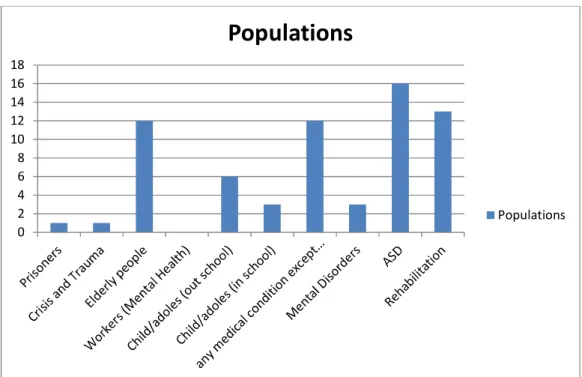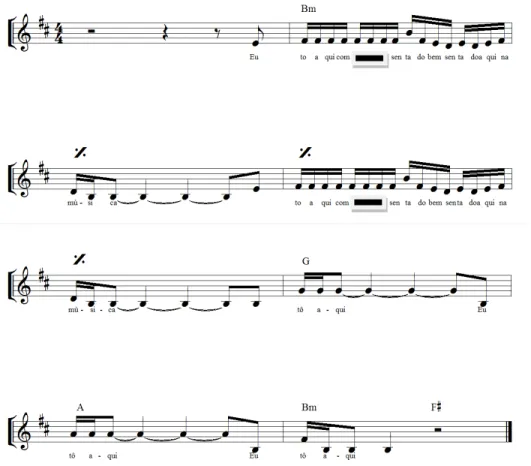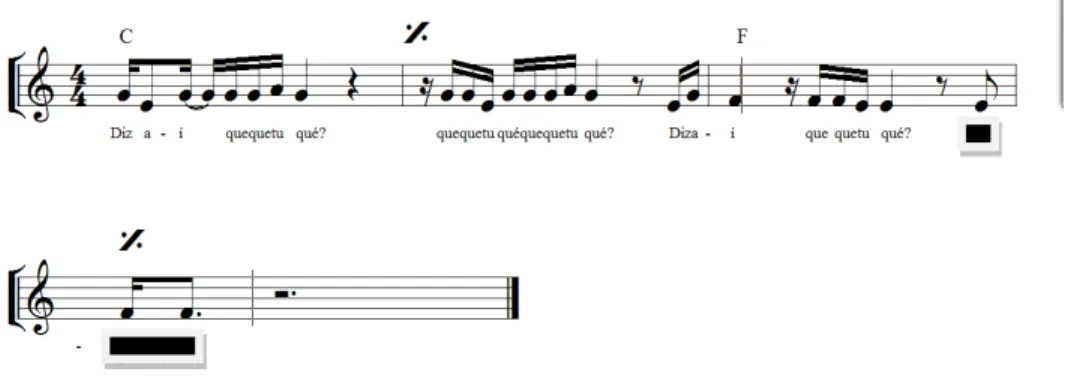Thanks to my mother Ivette, father Milton and brother Felipe. Music therapy in the treatment of people with autism spectrum disorders 4 Therapeutic use of songs and improvisation with.
AN EXAMPLE OF SESSION DESCRIPTION AND THE
AN EXAMPLE OF ANALYTIC MEMOAND THE
Valeria's development in terms of interests, initiative and regulation 108 13. Louie's development in terms of interests, initiative and regulation 121 14. Valeria's development in terms of commitment and attachment 113 19. Louie's development- in terms of engagement and connection20.
Populations
Moments of Chaos, Moments of Balance, and Response to it Through the Composition of the First Clinical Theme
In the first session, participants began to enter the music therapy room and Chad closed the door prematurely, accidentally leaving two clients outside the room. At this point it was clear that Chad was the one responsible for providing structure to the group dynamic. Within the first few minutes of the session, before the music started, Louie was running in the group and exhibiting aggressive behavior towards other group members.
The break suggested a relief in the tempo of each bar, giving the composition more lightness.

Trying to Find Balance Between Rigidity and Flexibility
The therapists experienced frustration at having to alternately deal with moments of chaos and balance in the group. In these meetings, as mentioned in the method section, the role of the researcher was to be a consultant. In the first of these meetings, the main theme seemed to be the therapists dealing with the initial dynamics of chaos and balance.
This research group reminded me of the first groups I used to run at the beginning of my career.
The Room is Transformed and there is a Call for Spontaneity
Chad and Carly agreed to face the rigidity and began to think about other mediation options that could allow for group structure and creative freedom. Chad suggested starting with lyrics and harmony taken from the reggae song "Eu tô aqui" (Here I Am), but offered a grounding without using the semi-trembling pause at the start of the measure. Although the group started disorganized, after about 10 minutes the group became more organized.
The black label on the score covers where the name of the customer was sung.

The Room was Rearranged and the Song “Que que tu qué” (What do you want?) is Re-created
In the second team meeting, after session 6, one of the topics raised by the researcher-consultant was aggressive behavior. It was noted that major clinical themes had emerged after 20 minutes into the sessions (see Appendix C), hypothesizing that although improvisation was present in the group, clients could experience the music in a more open rather than stimulating way. therapists for mutual production. In the meeting, Carly and Chad brought feelings of being more comfortable and creatively spontaneous to the process.
As a result of the therapists feeling more confident, comfortable and cohesive in the group, joy became more present.
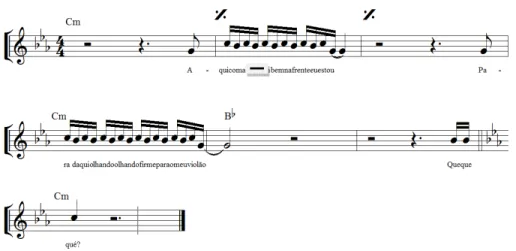
The Group Became More Active
Both therapists felt safer in relation to each other, to the group and to the process itself. Some clients remained seated and some stood in front of the therapists as they sang and played. When the music ended and the therapists started the farewell song, everyone was close to the keyboard.
The session ended with everyone close to each other, which showed more intimacy in the session.
Autonomy Begins to Occur
During the goodbye song to end the session, Chad asked participants to sit down and stayed between them and the keyboard. As Louie and Donald started running around the room, Carly and Chad started to back it up. Carly ran with the customers, and Chad improvised the song 'Corre, corre, corre, corre' (run, run, run, run).
Chad then asked Sonia to play the keyboard with him, which she did before the music and session ended.
Regression to Isolation and Rigidity
The requirements for this stage to start have been met: a) time; b) stable environment to help members feel safe;. After the music ended, Chad and Donald had an intimate, quiet moment where they communicated with each other with their hands and fingers. At the end of the session, Sonia spontaneously hugged Carly's neck and kissed her goodbye.
I went to the keyboard and became very self-centered, wanting to invest a lot in the music.
A New Clinical Theme and Relational Work Emerge
During the music, the band members were not sitting, but were exploring possibilities in an organized manner. When clients were distributed across the room, there was greater interaction between clients and therapists, but no interaction between clients. When Donald ran over to Carly and started pulling her smoothly, she started running around the room in a rhythmic pattern.
In doing so, Chad demonstrated a quick ability to hear the context of the game that Donald and Carly had started and assisted.
Parents are Present in Session
But when Chad made the song more rhythmic and energetic, Louie played bongos with his father for a few moments. Although Louie mostly ignored his father, he did briefly play his tambourine. Then Louie approached his father and put his hand over his father's mouth.
Carly kept the harmony in the keyboard and Chad played percussion with the guitar's wood.

Parents are Present Again
In this session, Louie and his father were able to share an instrument and an improvisational music experience. Throughout the session, Louie was sporadically physically distant from his father, but he was generally more receptive to his father's invitations to interact by playing instruments together. The therapists allowed the parents to sing to their children, and when the music ended, everyone clapped.
As Chad began his farewell song, Valerie's mother played with her daughter and Louie tearfully hugged his father.
The Last Session with Parents
At the end of the session Louie went over to the keyboard where Carly was playing with Joshua and joined her. At the end of the session, the therapists invited the clients to join them closer to the keyboard, where they completed the group together. Chad's expression of "giving voice" to the therapeutic incidents in the last session can be considered a good representation of the therapist's efforts to facilitate the clients' achievement of meaning through their expressions throughout the process.
Findings related to the research questions of this study will be presented in the following two chapters.

Intentionality and two-way communication. Babies begin
This developmental level refers to the ability to find interest and initiative in the external world, to see, listen and pay attention to it to the ability to find interest and initiative in the external world, to see, listen and pay attention to it (Greenspan & Wieder, 2006). When the baby's caregiver becomes a special person who brings joy, interactions improve and a new level of intelligence is reached. Through these exchanges, infants begin to engage in back-and-forth emotional signaling, or two-way communication.
The mother responds to the child's gesture and thereby closes the "circle of communication". Solving social problems appears in this phase.
Creating symbols and using words and ideas To understand and use words and language, children must first be able to engage in complex emotional
For this to happen, caregivers need to read and respond to babies' signals and encourage them to read and respond to theirs. For example, a baby smiles at its mother; he gets a smile back, so he smiles again. For example, if a friend doesn't want to play, the child might think, "Maybe he wants to play with someone else today." Perception of multicausality allows the child to engage in.
Multicasual and triangular thinking enable children to understand the varying degrees or relative triangular thinking enables children to understand the varying degrees or relative impacts of feelings, events, or phenomena (ie, "I'm just a little bit crazy;" Greenspan & Wieder, 2006).
A growing sense of self and reflection on an internal standard. By puberty and early adolescence, more complex emotional interactions help children
He showed some curiosity and openness to relationship with the therapists in the first session. She showed openness to the relationship with the therapists from session 2 through eye contact and smiling. It was in the stage of experiential engagement that he became more interactive with the therapists.
Donald and Gustavo were able to play with their peers with the help of the therapists. As shown in the tables presented, group members were able to interact with the therapists and peers. In other words, music worked side by side with the therapists and with the clients.
The Music Therapy Room has Therapeutic Plasticity
This was expected behavior in the first stage of the group process known as induction. Their position in the space and the organization of the space changed according to how they perceived group movements and dynamics. Sometimes Chad would go to the back of the room and Carly would stay in front of the half circle.
The therapists utilized the various capabilities of the music therapy room to better meet the needs of group members and the group as a whole.
Therapists have Expectations, Experience Frustration, and can Frustrate Clients
In other words, the therapists, who aimed to facilitate context, organization and meaning for the group experience, were not only concerned with musical, verbal and physical interventions, but were also concerned with the physical aspects of the music therapy room. The first example of an expectation can be seen in the way the therapists organized the music therapy room before the first session. Before getting to know the participants, Chad and Carly thought about possibilities for the music therapy room organization.
Once the music therapy room was organized in a certain way, the expectation they had was for clients to behave in a certain way.
Everybody Can Include and Everybody Can Exclude
As an example of this category, in session 12, Louie ran toward several parents who were playing with their children (ie, Donald's and Gustav's parents) and looked at them, indicating a desire for contact. In session 12, Chad finished the song with Louie by his side because Louie refused to sit next to his father. Regarding parent-child relationships, in session 12, Valerie's mother entered the music therapy room with chewing gum.
Regarding the relationship between therapists and parents, when Louie's father played a rhythmic sound on the Brazilian tambourine in the 14th session, the therapists ignored it and he was excluded.
The Challenge of Rigidity versus Freedom
This again indicates how the therapists experienced the dilemma of rigidity versus flexibility. Therapists and clients did not seem to enjoy creativity at the beginning of the process. Creating reggae has shown therapists and clients that there are possibilities for greater flexibility and fun in the process.
Therapists were still dealing with their exclusionary forces and there were often distractions in the room.
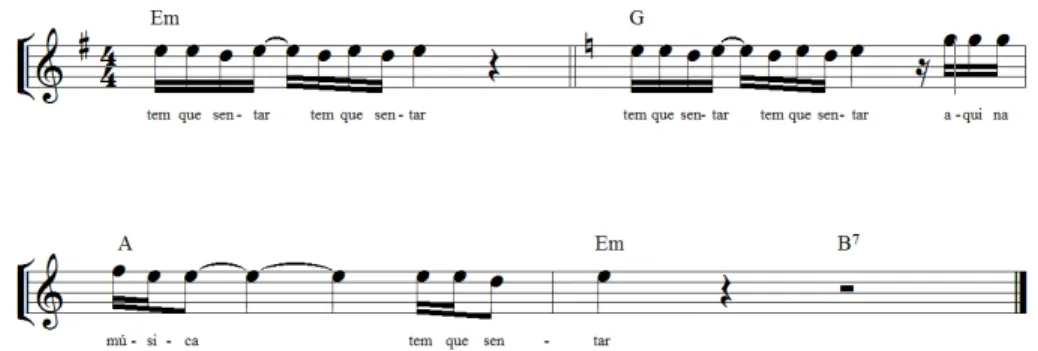
The Importance of Integrating Parents into Clients’ Developmental Processes and Reflections on Symptoms
The involvement of parents in the therapeutic processes of their sons and daughters in music therapy is not something new. Louie and Valeria were seen playing with their respective parents and receiving hugs from them was an important indicator of music therapy interventions. The study findings have clinical implications by stimulating a discussion about music therapy with people with ASD.
Contributions of Nordoff-Robbins music therapy within a developmental framework based on individual differences and relationships (DIR)/Floortime to the treatment of children with autism: Four case studies.

June/JULY
- TEM QUE SE SENTAR (YOU HAVE TO SIT DOWN) 28:30 min of session 1
- EU TÔ AQUI (I AM HERE) – REGGAE 2 25:52 min of session 2
- VALERIA’S SCREAM IN D 23:00 min of session 3
- QUE QUE TU QUÉ? (WHAT DO YOU WANT?) 33:40 min of session 5
- SONG 6: RECREATION OF “QUE QUE TU QUÉ?” (WHAT DO YOU WANT?) 4
- THE RHYTHMICAL CALL 25:45 min of session 7
- SONG 7: “A GALERA VAI CURTINDO ESSA CANÇÃO" (GUYS ARE HAVING FUN WITH THIS SONG)
- COM O PAI E COM A MÃE" (WITH MOM AND WITH DAD) 29:20 min of session 12 (with parents)
- O LOUIE VEIO PRA MÚSICA" (LOUIE CAME TO MUSIC) 0:30 min of session 16
- DANÇA” (DANCE) 15:18 min of session 16
2 The black label on the score is the area where the name of the client is included. 3 The black marker on the score is the area where the name of the client is included. 4 The black label on the score is the area where the name of the customer is included.
